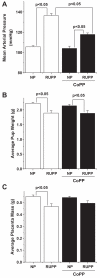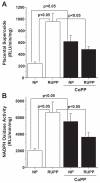Induction of heme oxygenase 1 attenuates placental ischemia-induced hypertension
- PMID: 21383306
- PMCID: PMC3085942
- DOI: 10.1161/HYPERTENSIONAHA.111.169755
Induction of heme oxygenase 1 attenuates placental ischemia-induced hypertension
Abstract
Recent in vitro studies have reported that heme oxygenase 1 (HO-1) downregulates the angiostatic protein soluble fms-like tyrosine kinase 1 from placental villous explants and that the HO-1 metabolites CO and bilirubin negatively regulate endothelin 1 and reactive oxygen species. Although soluble fms-like tyrosine kinase 1, endothelin 1, and reactive oxygen species have been implicated in the pathophysiology of hypertension during preeclampsia and in response to placental ischemia in pregnant rats, it is unknown whether chronic induction of HO-1 alters the hypertensive response to placental ischemia. The present study examined the hypothesis that HO-1 induction in a rat model of placental ischemia would beneficially affect blood pressure, angiogenic balance, superoxide, and endothelin 1 production in the ischemic placenta. To achieve this goal we examined the effects of cobalt protoporphyrin, an HO-1 inducer, in the reduced uterine perfusion pressure (RUPP) placental ischemia model and in normal pregnant rats. In response to RUPP treatment, mean arterial pressure increases 29 mm Hg (136±7 versus 106±5 mm Hg), which is significantly attenuated by cobalt protoporphyrin (118±5 mm Hg). Although RUPP treatment causes placental soluble fms-like tyrosine kinase 1/vascular endothelial growth factor ratios to alter significantly to an angiostatic balance (1.00±0.10 versus 1.27±0.20), treatment with cobalt protoporphyrin causes a significant shift in the ratio to an angiogenic balance (0.68±0.10). Placental superoxide increased in RUPP (952.5±278.8 versus 243.9±70.5 relative light units/min per milligram) but was significantly attenuated by HO-1 induction (482.7±117.4 relative light units/min per milligram). Also, the preproendothelin message was significantly increased in RUPP, which was prevented by cobalt protoporphyrin. These data indicate that HO-1, or its metabolites, is a potential therapeutic for the treatment of preeclampsia.
Figures





Similar articles
-
Heme oxygenase-1 is a potent inhibitor of placental ischemia-mediated endothelin-1 production in cultured human glomerular endothelial cells.Am J Physiol Regul Integr Comp Physiol. 2018 Mar 1;314(3):R427-R432. doi: 10.1152/ajpregu.00370.2017. Epub 2017 Dec 6. Am J Physiol Regul Integr Comp Physiol. 2018. PMID: 29212810 Free PMC article.
-
Exercise training attenuates placental ischemia-induced hypertension and angiogenic imbalance in the rat.Hypertension. 2012 Dec;60(6):1545-51. doi: 10.1161/HYPERTENSIONAHA.112.202275. Epub 2012 Oct 22. Hypertension. 2012. PMID: 23090773 Free PMC article.
-
Placental growth factor reverses decreased vascular and uteroplacental MMP-2 and MMP-9 and increased MMP-1 and MMP-7 and collagen types I and IV in hypertensive pregnancy.Am J Physiol Heart Circ Physiol. 2018 Jul 1;315(1):H33-H47. doi: 10.1152/ajpheart.00045.2018. Epub 2018 Mar 23. Am J Physiol Heart Circ Physiol. 2018. PMID: 29569955 Free PMC article.
-
Heme oxygenase-1 in placental development and pathology.Placenta. 2013 Apr;34(4):291-8. doi: 10.1016/j.placenta.2013.01.004. Epub 2013 Feb 9. Placenta. 2013. PMID: 23403148 Review.
-
Bioactive factors in uteroplacental and systemic circulation link placental ischemia to generalized vascular dysfunction in hypertensive pregnancy and preeclampsia.Biochem Pharmacol. 2015 Jun 15;95(4):211-26. doi: 10.1016/j.bcp.2015.04.012. Epub 2015 Apr 24. Biochem Pharmacol. 2015. PMID: 25916268 Free PMC article. Review.
Cited by
-
Interaction Between NOS3 and HMOX1 on Antihypertensive Drug Responsiveness in Preeclampsia.Rev Bras Ginecol Obstet. 2020 Aug;42(8):460-467. doi: 10.1055/s-0040-1712484. Epub 2020 Jun 19. Rev Bras Ginecol Obstet. 2020. PMID: 32559798 Free PMC article.
-
Heme oxygenase-1 in pregnancy and cancer: similarities in cellular invasion, cytoprotection, angiogenesis, and immunomodulation.Front Pharmacol. 2015 Jan 14;5:295. doi: 10.3389/fphar.2014.00295. eCollection 2014. Front Pharmacol. 2015. PMID: 25642189 Free PMC article. Review.
-
Heme oxygenase (HO-1) rescue of adipocyte dysfunction in HO-2 deficient mice via recruitment of epoxyeicosatrienoic acids (EETs) and adiponectin.Cell Physiol Biochem. 2012;29(1-2):99-110. doi: 10.1159/000337591. Epub 2012 Mar 1. Cell Physiol Biochem. 2012. PMID: 22415079 Free PMC article.
-
Heme oxygenase inhibition increases blood pressure in pregnant rats.Am J Hypertens. 2013 Jul;26(7):924-30. doi: 10.1093/ajh/hpt045. Epub 2013 Apr 3. Am J Hypertens. 2013. PMID: 23553216 Free PMC article.
-
Interleukin-17 signaling mediates cytolytic natural killer cell activation in response to placental ischemia.Am J Physiol Regul Integr Comp Physiol. 2020 Jun 1;318(6):R1036-R1046. doi: 10.1152/ajpregu.00285.2019. Epub 2020 Apr 22. Am J Physiol Regul Integr Comp Physiol. 2020. PMID: 32320265 Free PMC article.
References
-
- Roberts JM, Cooper DW. Pathogenesis and genetics of pre-eclampsia. Lancet. 2001;357:53–56. - PubMed
-
- Granger JP, Alexander BT, Llinas MT, Bennett WA, Khalil RA. Pathophysiology of preeclampsia: linking placental ischemia/hypoxia with microvascular dysfunction. Microcirculation. 2002;9:147–160. - PubMed
-
- Meis PJ, Goldenberg RL, Mercer BM, Iams JD, Moawad AH, Miodovnik M, Menard MK, Caritis SN, Thurnau GR, Bottoms SF, Das A, Roberts JM, McNellis D. The preterm prediction study: risk factors for indicated preterm births. Maternal-Fetal Medicine Units Network of the National Institute of Child Health and Human Development. Am J Obstet Gynecol. 1998;178:562–567. - PubMed
-
- Zandi-Nejad K, Luyckx VA, Brenner BM. Adult hypertension and kidney disease: the role of fetal programming. Hypertension. 2006;47:502–508. - PubMed
-
- Sibai B, Dekker G, Kupferminc M. Pre-eclampsia. Lancet. 2005;365:785–799. - PubMed
Publication types
MeSH terms
Substances
Grants and funding
LinkOut - more resources
Full Text Sources
Medical
Miscellaneous

